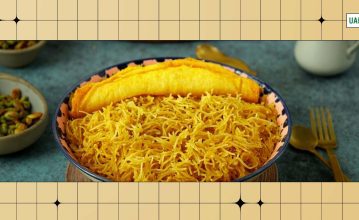The national dish of UAE, the Machboos is more than a meat and scenting rice dish—it’s an emblem of cuisine that bears witness to the Emirates’ history, heritage, and hospitality.
With a savory aroma that is strong, high-quality spices, and whole foods ingredients, Machboos has taken pride of place in Emirati domestic life for centuries.
This foreign dish fuses the flavor of Middle Eastern cuisine with that of the region’s surrounding Gulf and Asian countries to produce a thick meal that, although it is so, still stays firmly rooted in national traditions.
Machboos Historical Background

The origin of Machboos dates to centuries of cross-cultural and trade relationships within the Arabian Peninsula. Traditionally, the UAE has been a hub for Indian, Persian, and East African merchants.
The merchants exported an assortment of spices—cinnamon, cloves, cardamom, and turmeric—from there back in the region, which later impacted the flavor of Machboos.
Traditionally, Machboos were cooked in huge cauldrons over open fires to serve communally to everyone for occasions like weddings, Eid, and guests—a testament to the Emirati tradition of hospitality (karam) to extend such generosity to others.
The Cultural Significance of the National Dish of UAE

Machboos holds a unique place in Emirati homes. It is not food alone; it’s gathering, hospitality, and family time.
Machboos is an act of gathering, and in old homes, it is taken to the dining area as one unifying dish serving in the center of the floor where everyone gathers and shares.
Even today, even with modernization of UAE food, Machboos remains a favorite with the Emiratis—both at home and in high-end restaurants.
Main Ingredients in Machboos

The key to Machboos’s unique flavor lies in the right mix of ingredients. The main ingredients are generally:
- Rice – Basmati long-grain rice is utilized as it is light.
- Meat-Chicken or lamb is most favored, though Chicken Machboos is the preferred variety.
- Dried limes (loomi)-To give a sour smoky flavor undertone characteristic of authentic Machboos.
- Spices: A warm application of turmeric, cinnamon, cardamom, cloves, cumin, and bay leaves
- Onions, garlic, and ginger: To give depth of savory base
- Tomatoes: To give richness and subtle sweetness.
- Stock or broth – To season the rice.
Traditional Preparation of Machboos

How national dish of UAE is cooked is as important as what it’s cooked with:
- Cooking the Aromatics – Onions, garlic, and ginger are sautéed in oil until the oil turns golden.
- Toasting Spices – Spice mixture is put in so that it can emit its aroma.
- Brown the Meat – Chicken, lamb, or fish are browned and cooked together with tomatoes and dried limes.
- Add Rice and Stock – Basmati rice is added to the spiced broth, and it absorbs all the flavor.
- Slow Cooking – The dish is slow-cooked until the rice is light and fluffy and the meat is soft.
Machboos is typically needs a large pot at home to cook, and all the spices mix together so well.
What are the Common Machboos Variations?
Although chicken Machboos is the most popular, there are others as well:
- Lamb Machboos – More flavorful and served on special occasions.
- Fish Machboos – Seafood version using fresh fish.
- Vegetarian Machboos – Chickpeas, carrot, and potato as a substitute.
When is Machboos Served?

In Emirati dining tables, the UAE national dish is a special occasional Emirati food:
- Eid celebrations
- Weddings
- Ramadan iftar lunches
- Receiving honored guests
This is similar for every home in the Emirates, where Friday is family lunch day.
Nutritional Value

Nutritionally, Machboos is a nutritious dish since it incorporates:
- Protein – Chicken, lamb, or fish.
- Complex carbohydrates – Rice.
- Vitamins and minerals – Spices, tomatoes, and aromatics.
- Health fats – With little usage of cooking oil.
The consumption, however, is in moderation due to its strong taste and generous serving sizes.
New Trends in the UAE National Dish
Although Machboos is extremely traditional, Dubai and Abu Dhabi cooks are developing creative solutions:
- To serve it – In individual servings or with creative plating.
- Add gourmet tastes – Combining saffron, nuts, or dried fruits.
- To remain healthy – Replacing brown rice or lowering-fat protein.
All these innovations make Machboos modern and fashionable throughout generations. You can also find original Machboos in the right Emirati restaurants such as:
- Al Fanar Restaurant & Café
- Seven Sands
- Logma
- Right Emirati family restaurants
Machboos are even part of the Arabic buffet of all the hotels.
FAQs
Here are a few queries that others have raised on the topic of the national dish of UAE, that you might find helpful as well.
Khuzi, also called Ghuzi, the dish is also considered as the national food of UAE alongside Al Machboos. The Khuzi is a wholesome dish, preparing with either roasted mutton or lamb and served on top of rice, some vegetables and nuts.
The Harees is one of the most popular dishes of Dubai. It is very common on Emirate dinner tables food along with fine dining restaurants.
The date is the national fruit of UAE. This fruit is the cornerstone of the Emirati culture, since the country has over 40 million date palms that produces more than 150 different types of dates.
Machboos – National Dish of UAE
The national dish of UAE, Machboos, is not only delicious—Machboos is Emirati history, a history of commerce, hospitality, and humanity.
Served in an Emirati home, local café, or national festival, Machboos unites people with its divine taste and heritage.
Through maintaining and preserving Machboos, the UAE guarantees future generations the honor of not only enjoying but studying and even loving the history and affection that goes into this iconic dish.









